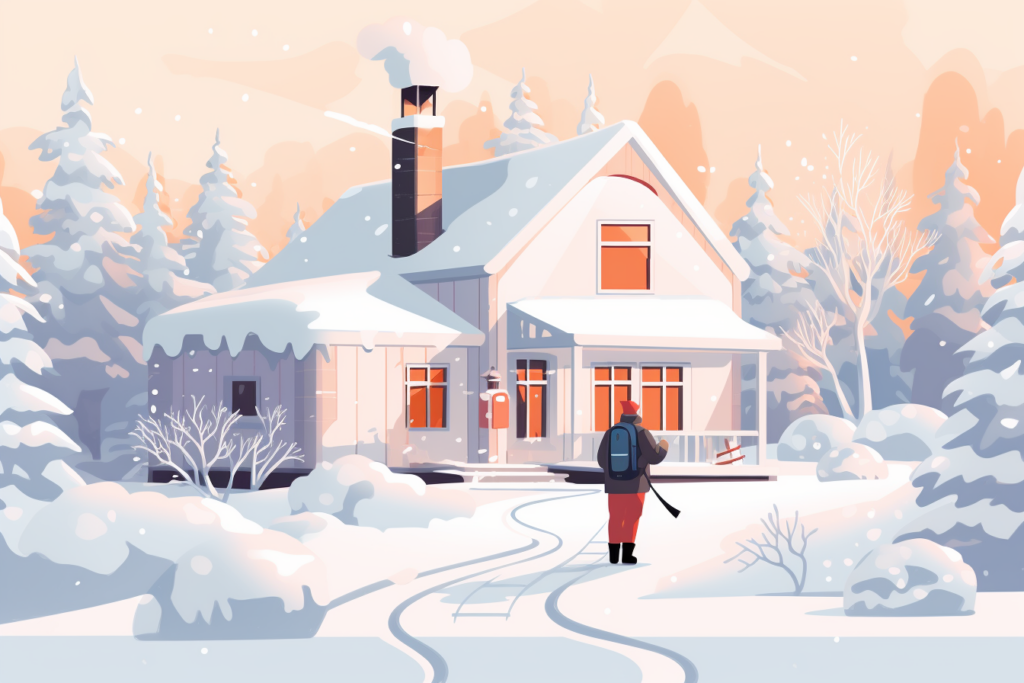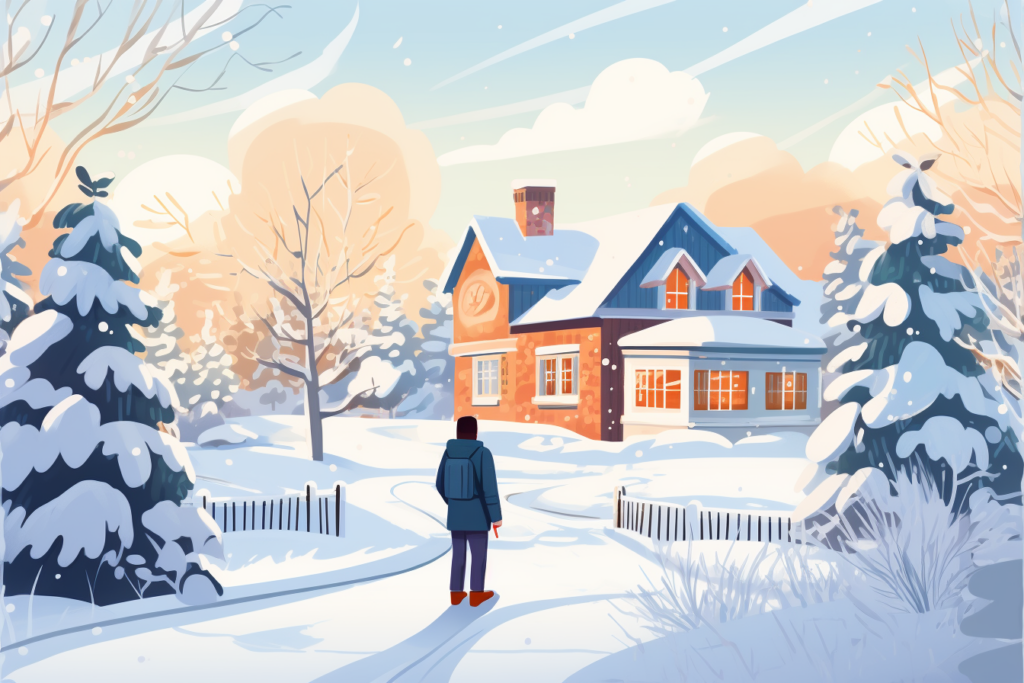Winter’s chill changes not only the weather but also the need to prepare our homes for the colder months. Winterizing your home is essential to ensure it is cozy, safe, and energy-efficient. Here’s an expanded guide to help you prep your home for winter and enjoy the season to the fullest.
Continue reading to learn more about 13 ways to prepare your home for the winter season and reduce the stress that often comes with cold weather.
1. Insulate to Stay Warm
Proper insulation is crucial in keeping your home warm. Check the insulation in common places that are prone to letting in air. (attics, basements and crawl spaces). Adding insulation where necessary can significantly reduce heating costs.
Tips & Tricks
- Home Energy Audit: Consider having a professional energy audit to assess the insulation levels in your home. This can help identify areas where insulation is lacking or inefficient.
- Types of Insulation: Depending on your needs, you might use fiberglass, cellulose, foam board, or spray foam insulation. Each type has its advantages and is suited for different areas of the home.
- R-Value: Ensure the insulation material has an appropriate R-value (a measure of thermal resistance) for your climate and the specific area of your home.
2. Seal Windows and Doors
Combat Drafts: Drafts can significantly increase your heating bills. Inspect windows and doors for gaps and use weather stripping, caulk, or draft stoppers to seal them. For an extra layer of insulation, consider using thermal curtains.
Tips & Tricks
- Ductwork: Inspect the ductwork for leaks, especially in unconditioned spaces like attics or basements. Sealing and insulating ducts can significantly improve your home’s energy efficiency.
3. Heating System Maintenance
Keep the heat running; your heating system will work overtime during winter. Ensure it’s up to the task by replacing filters, cleaning vents, and getting a professional inspection to avoid mid-winter breakdowns.
Tips & Tricks:
- Consider opting for a Smart Thermostat to regulate your heating and reduce energy bills when you are away or in specific rooms.
4. Prepare the Fireplace
An annual inspection and cleaning are essential to prevent chimney fires and carbon monoxide entry if you have a fireplace. Ensure the damper opens and closes correctly, and stock up on firewood for wood-burning fireplaces.
Tips & Tricks:
- Inspect for Cracks and Damage: Look for any visible damage to the fireplace structure, including the chimney and hearth. Look for cracks and loose bricks that might need to be replaced.
- Clear Obstructions: Ensure the chimney is free of obstructions like bird nests, leaves, or other debris that can block airflow and lead to dangerous carbon monoxide buildup.
- Fireplace Tools: Have the necessary tools on hand, including a poker, tongs, shovel, brush, and ash bucket.
- Install a Chimney Cap: If you don’t already have one, install a chimney cap to remove debris and animals.
- Seasoned Wood: Burn only dry, seasoned wood. Green or wet wood produces more creosote, which can lead to chimney fires.
5. Guard Against Frozen Pipes

Frozen pipes are a common and costly problem. Insulate pipes, especially those in unheated areas. Keep your home at a consistent temperature and allow faucets to drip during extremely cold weather to prevent freezing.
Tips & Tricks
- Water Heater: Consider insulating your water heater or adding an insulation blanket if it’s an older model.
- Prioritize Exposed Pipes: Focus on pipes in unheated or vulnerable areas like basements, attics, garages, and exterior walls.
- Foam Tubing: Pre-slit foam pipe insulation is a common and practical choice. It’s easy to install and comes in various sizes to fit different pipe diameters.
- Fiberglass or Foam Wraps: These are useful for pipes in tight spaces or with many bends. They can be wrapped and secured with tape.
- Ensure a Snug Fit: Cut the insulation to the length of the pipes and ensure it fits snugly around them. For foam tubing, the slit should be firmly sealed along the pipe’s length.
- Secure the Insulation: Use duct tape, cable ties, or specialized insulation tape to secure foam wraps or sections where the insulation does not self-seal.
- First Few Feet: Insulating the first few feet of both hot and cold water pipes connected to the water heater improves energy efficiency.
6. Clear the Gutters
Water damage and ice dams are caused by clogged gutters and can usually be avoided if addressed before the winter season starts. Clean them out to ensure proper drainage, and consider installing gutter guards for easier maintenance.
7. Check the Roof
It is always good to inspect your roof regularly for any signs of damage, such as missing or broken shingles, which could lead to leaks during snow and rain. If you’re not comfortable doing this yourself, hire a professional.
8. Emergency Kit and Supplies
Assemble an emergency kit containing essentials like flashlights, batteries, a first-aid kit, blankets, and a portable charger. Stockpile necessities such as non-perishable food, water, and medications in case of a power outage or severe storm.
9. Outdoor Area Maintenance
Store or cover outdoor furniture and gardening tools. Drain outdoor faucets and hoses to prevent freezing. Clean and store your lawnmower and other gardening equipment.
10. Cozy Interior Upgrades
Warm Decor: Beyond practical steps, make your home more comfortable with warm blankets, throw rugs, and heavy drapes. These not only add warmth but also create a cozy, inviting atmosphere.
Tips & Tricks:
- Don’t forget the basement! Insulating basement walls and floors can prevent cold floors in the winter and reduce the chances of pipes freezing.
11. Safety Checks
Regularly testing your smoke and carbon monoxide detectors is also important to home safety. This is particularly important in winter when the house is closed up, and heating systems are constantly used.
12. Tree and Landscaping Care
Heavy snow and ice are known to cause tree limbs to break and potentially damage your home or power lines. Trim any overhanging branches, especially those near your house or electrical wires.
13. Garden and Plant Protection
Protect sensitive plants with frost cloth or mulch. Clean up fallen leaves and debris, which can become wet and slippery during winter.
Tips & Tricks:
- Climate Understanding: Understand your local climate and your area’s hardiness zone. This knowledge will guide you on which plants need more protection and which can withstand local winter conditions.
- Hydration: Ensure your plants are well-watered before the first frost. Moist soil retain heat much better than dry soil, providing extra warmth around the roots.
- Bring Indoors: Move sensitive plants and tropical perennials indoors or into a greenhouse.
- Remove Dead Parts: Prune dead or weakened branches from trees and shrubs. Deadheading spent flowers and removing dead leaves from plants can also help them conserve energy during winter.
Conclusion
Preparing your home for winter is about creating a safe, warm, and efficient environment. Tackling these tasks before the cold sets in can prevent last-minute emergencies and costly repairs. So, as the temperatures drop, take the time to winterize your home – your future self will thank you for a season of comfort and peace.
You might also be interested in: The 10 Best Home Improvement Projects For Winter




